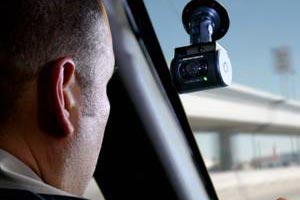Driver Cameras Keeping Some Trucking Companies Out of Court

Ten years ago, if an 18-wheeler was involved in an accident, the trucking company could end up paying, even if the truck driver was not at fault.
A piece of new technology has changed that. Cameras pointing forward and at the driver record what occurs in such incidents and can clear the trucker if he or she was not to blame.
“SmartDrive cameras in the truck and in the cab protect the driver in case of an accident,” said Bill Buckley, personnel and safety director for Milton Transportation. “It’s saved a lot of drivers’ butts here.”
RELATED: Trucking firms find success, challenges with driver cameras
Jared Brokenshire, director of operations at Watsontown Trucking, said that in a recent case, a car accelerated past a Watsontown truck then spun out of control. The truck could not avoid hitting the car. A case was filed against the company, but after Watsontown submitted the videos, the case was dropped, Brokenshire said.
“We might have ended up paying,” he said.
Brokenshire said cameras face backward and forward and record on continuous 12-second loops.
“If ever they’re even hitting the brakes, anything that would shake the truck, it will take the previous 8 seconds and record the next 4,” he said.
Buckley said he had his doubts at first, when the cameras were installed about a year ago.
“I was reluctant to be in a truck with cameras,” he said, “but I have seen how beneficial they are.”
If, for example, a driver is accused of falling asleep at the wheel, the video will show whether he was.
Brokenshire said some drivers might be worried about their privacy, but the cameras cannot see them at all times.
“It’s for their protection,” he said.
He said another safety feature, collision avoidance systems, includes detectors on the bumpers that measure the gap between the truck and other objects and monitor the truck’s speed and following distance. If the truck is approaching another vehicle or object too quickly, the device will turn off the cruise control and, in the newer trucks, start to apply the brakes.
If the truck starts to approach the line in the road without the turn signal applied, a device will send an audible signal to the driver, Brokenshire said.
The company drivers also use electronic driver logs to record how long they have been driving.
“It monitors everything for them in terms of when they have to take their break and how much time they have available before they have to take a break,” Brokenshire said.
He said drivers can drive for up to 11 hours within a 14-hour window. Even if they have just driven an hour or two in a 14-hour period, when they hit 14 hours, they must take a break, he said.
Buckley said trucking companies will be mandated to begin using electronic logging by Dec. 16 of this year, but Milton Transportation will have them before that deadline. “There’s going to be a learning curve,” he said. “It will make them manage their time better.”
Other new technology will be coming in the future.
“There are going to be a lot of changes on the engines to make them more fuel-efficient — and alternative fuels,” Brokenshire said.
But one change both company representatives said the industry might not be ready to begin employing is the autonomous, or driverless, trucks, which some industry experts say could be coming within five years.
Brokenshire doesn’t think it will be that soon.
“I could see a piggyback, a train of two or three trucks with the first having a truck driver,” he said. “There’s pros and cons [to autonomous trucks]. I don’t think we’re quite ready for that.”
Buckley said he didn’t know if they would be good or bad.
“I knew the technology has been coming for this,” he said. “Are we there yet? I don’t know yet. There’s an awful shortage of truck drivers. I would like to see more tests done on them. What if it runs a stop sign due to a computer malfunction?”
Ken Wolfe, a mechanic at Milton Transportation, said he hasn’t read enough about the autonomous trucks to know much about them, but he added, “With all the conditions out there on the road that these drivers have to deal with, I’d be leery to have an 80,000-pound truck out there without a driver in it.”

